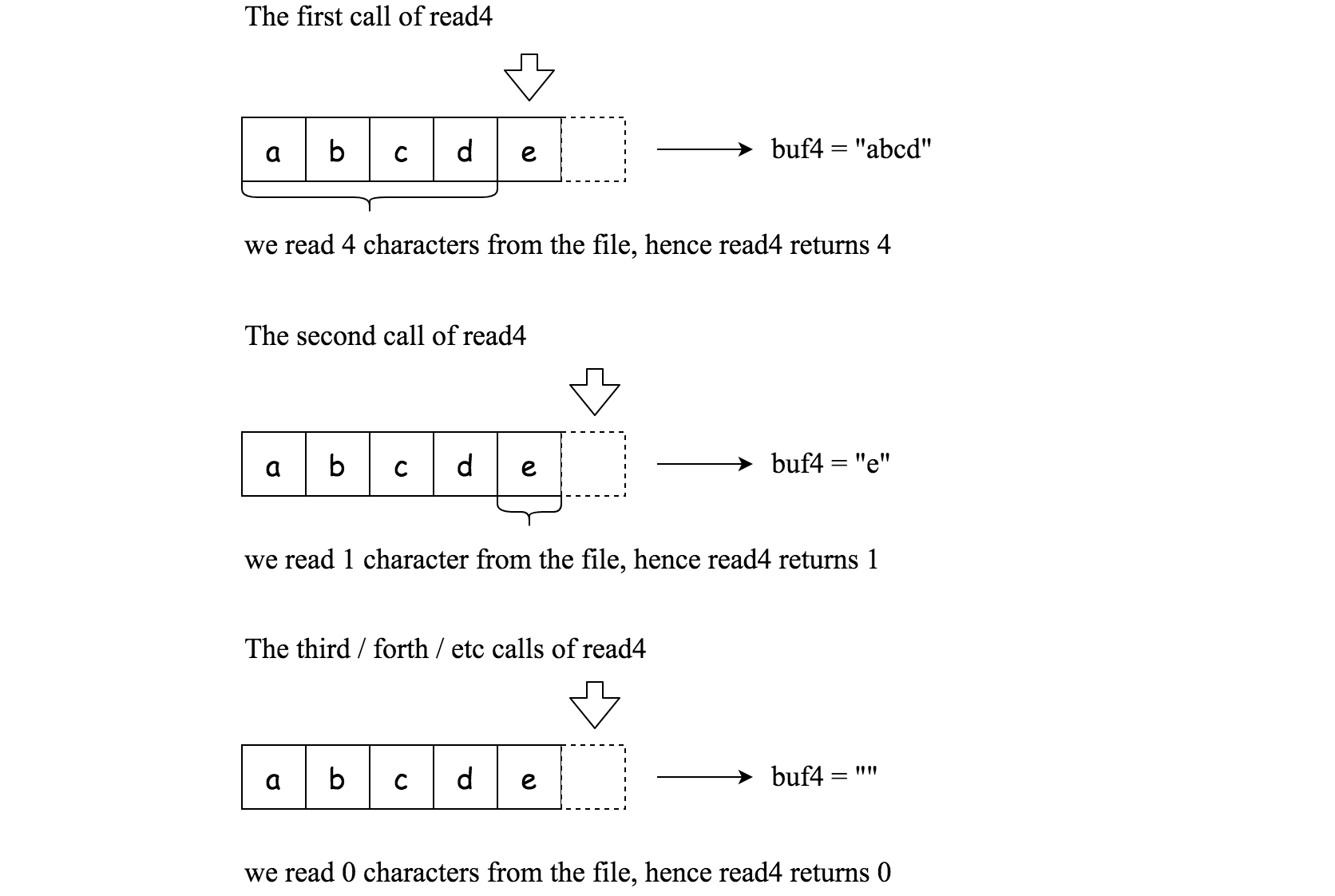Question
Given a file and assume that you can only read the file using a given method read4, implement a method read to read n characters. Your method read may be called multiple times.
Method read4:
The API read4 reads four consecutive characters from file, then writes those characters into the buffer array buf4.
The return value is the number of actual characters read.
Note that read4() has its own file pointer, much like FILE *fp in C.
Definition of read4:
Parameter: char[] buf4
Returns: int
buf4[] is a destination, not a source. The results from read4 will be copied to buf4[].
Below is a high-level example of how read4 works:

File file("abcde"); // File is "abcde", initially file pointer (fp) points to 'a'
char[] buf4 = new char[4]; // Create buffer with enough space to store characters
read4(buf4); // read4 returns 4. Now buf4 = "abcd", fp points to 'e'
read4(buf4); // read4 returns 1. Now buf4 = "e", fp points to end of file
read4(buf4); // read4 returns 0. Now buf4 = "", fp points to end of file
Method read:
By using the read4 method, implement the method read that reads n characters from file and store it in the buffer array buf. Consider that you cannot manipulate file directly.
The return value is the number of actual characters read.
Definition of read:
Parameters: char[] buf, int n
Returns: int
buf[] is a destination, not a source. You will need to write the results to buf[].
Note:
- Consider that you cannot manipulate the file directly. The file is only accessible for
read4but not forread. - The read function may be called multiple times.
- Please remember to RESET your class variables declared in Solution, as static/class variables are persisted across multiple test cases. Please see here for more details.
- You may assume the destination buffer array,
buf, is guaranteed to have enough space for storingncharacters. - It is guaranteed that in a given test case the same buffer
bufis called byread.
Example 1:
Input: file = "abc", queries = [1,2,1]
Output: [1,2,0]
Explanation: The test case represents the following scenario:
File file("abc");
Solution sol;
sol.read(buf, 1); // After calling your read method, buf should contain "a". We read a total of 1 character from the file, so return 1.
sol.read(buf, 2); // Now buf should contain "bc". We read a total of 2 characters from the file, so return 2.
sol.read(buf, 1); // We have reached the end of file, no more characters can be read. So return 0.
Assume buf is allocated and guaranteed to have enough space for storing all characters from the file.
Example 2:
Input: file = "abc", queries = [4,1]
Output: [3,0]
Explanation: The test case represents the following scenario:
File file("abc");
Solution sol;
sol.read(buf, 4); // After calling your read method, buf should contain "abc". We read a total of 3 characters from the file, so return 3.
sol.read(buf, 1); // We have reached the end of file, no more characters can be read. So return 0.
Constraints:
1 <= file.length <= 500fileconsist of English letters and digits.1 <= queries.length <= 101 <= queries[i] <= 500
Approach
- The question is hard to understand and the output is a string(despite that the function returns integer), then I guess it's returning the last buffer ;
- First question 157 is easier, the read is called only once so you can focus on the functionality.
- 158 is a follow up that tells you that read is called many time. In such condition, we need to consider there is :
- performance issue or(algorithm optimization or lock);
- The function call are relegate or affects each other
Code1
/** * The read4 API is defined in the parent class Reader4. * int read4(char[] buf4); */ public class Solution extends Reader4 { /** * @param buf Destination buffer * @param n Number of characters to read * @return The number of actual characters read */ public int read(char[] buf, int n) { int res = 0; boolean eof = false; char[] temp = new char[4]; while (!eof && res < n) { int count = read4(temp); if (count < 4) eof = true; count = Math.min(n - res, count); for (int i = 0; i < count; i++) { buf[res++] = temp[i]; } } return res; } }
Code2
Keep a buffer of size 4 as a class variable, call it prevBuf. Whenever we call read(n), read from prevBuf first until all characters in prevBuf are consumed (to do this, we need 2 more int variables prevSize and prevIndex, which tracks the actual size of prevBuf and the index of next character to read from prevBuf). Then call read4 to read characters into prevBuf. The code is quite clean I think.
public class Solution extends Reader4 { char[] prevBuf = new char[4]; int prevSize = 0; int prevIndex = 0; public int read(char[] buf, int n) { int counter = 0; while (counter < n) { if (prevIndex < prevSize) { buf[counter++] = prevBuf[prevIndex++]; } else { prevSize = read4(prevBuf); prevIndex = 0; if (prevSize == 0) { // no more data to consume from stream break; } } } return counter; } }